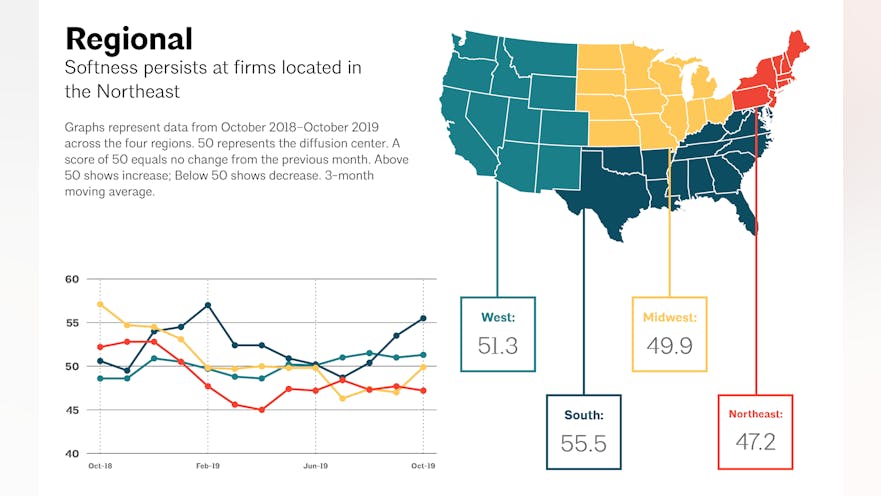September Construction Employment Rose by 25K
When to Start Worrying About Your Backlog
US DOE to Present Awards for Rooftop HVAC Excellence
High Marks for School Efficiency
Construction contractors were optimistic about 2020 until this fall when expectations for next year’s sales began to crumble. The latest Associated Builders and Contractors’ Construction Confidence Index sees contractors’ confidence taking a slight dip.
“[However,] only one in six contractors expect margins to decline over the next six months,” says Anirban Basu, ABC’s chief economist. “What’s more, industry employment continues to expand as the average firm works ever harder to secure talent. Fewer than one in 10 contractors anticipate that staffing levels will slip over the near term.”
Nonresidential construction spending in September saw a slight reduction from the previous year, Basu notes, with private nonresidential spending taking a hit primarily from the retail and lodging sectors.
The Architectural Billings Index rebounded a bit in October after flat or declining billings most of the year. “In general, architecture firms remain cautiously optimistic about the future, despite ongoing concerns about a potential economic downturn in the next year,” the report notes.
And while Dodge Data and Analytics notes in its 2020 Dodge Construction Outlook that total U.S. construction starts will slip to $776 billion in 2020, a decline of 4 percent from the 2019 estimated level of activity, it states that the industry is looking at a slowdown, not a contraction.
“Easing economic growth driven by mounting trade tensions and lack of skilled labor will lead to a broad-based but orderly pullback in construction starts in 2020,” the report says. “Next year, however, will not be a repeat of what the construction industry endured during the Great Recession. … The dollar value of starts for residential buildings will be down 6 percent, while starts for both non-residential buildings and nonbuilding construction will drop 3 percent.”
HVAC Trends
So, what does this mean for the HVAC industry? The most recent stats indicate that housing starts showed a decline of 8.6 percent from August. With some uncertainty about the home construction market, the nonresidential sector may be the best focus of the HVAC industry next year as building owners continue to upgrade heating and cooling equipment for energy savings.
Section 179 of the Internal Revenue Code was amended in 2017 by the Tax Cuts and Jobs Act. It allows businesses to deduct up to $1 million of the total cost of an HVAC purchase for the first year the system is used up to a maximum purchase price of $2.5 million. These tax benefits will begin to phase out in 2023, so 2020 is the perfect time to offer commercial customers some energy-efficiency upgrades.
Higher efficiency means the introduction of smart HVAC technology, which provides more control over comfort systems, even remotely through mobile apps. Advanced
algorithms allow equipment to learn the habits of occupants and to anticipate occupant needs.
Integrating HVAC with other building systems such as lighting as part of the building automation system is another ongoing construction trend toward increasing energy efficiency in commercial buildings.
Heating and cooling systems using renewable energy such as geothermal and solar are becoming more popular, as are variable refrigerant flow equipment. Several manufacturers have introduced evaporative cooling systems with desiccant material to remove humidity from the cooled air before distribution in the building.
Several manufacturers have introduced evaporative cooling systems with desiccant material to remove humidity from the cooled air before distribution in the building.
Heat pump systems continue to make a foray into the market; shipments of air-source heat pumps increased 6 percent from 2018, notes the Air-Conditioning, Heating and Refrigeration Institute in its latest report on U.S. shipments of heating and cooling equipment.
These technologies are designed to provide efficiencies in energy consumption as well as high performance. Some may cost more upfront, but the payback in energy savings can be significant for building owners.
The next year will see the complete phase-out of R-22 refrigerant in new equipment, effective Jan. 1, 2020. The refrigeration industry has seen low global warming potential substitutes over the last few years, although there is some concern over those considered mildly flammable.
Natural refrigerant solutions such as carbon dioxide (better heat exchange) and ammonia (increased efficiency) are gaining ground in some areas, although ammonia is not to be used in commercial applications due to its toxicity and flammability. It is primarily used in industrial refrigeration.
Take the temperature of your local market to see if your company can introduce or expand these technologies to customers. Depending on the local housing market,
changing focus to commercial customers may be the smart move in 2020.








